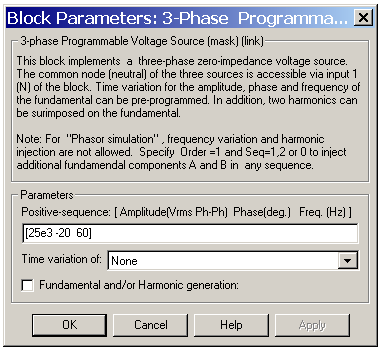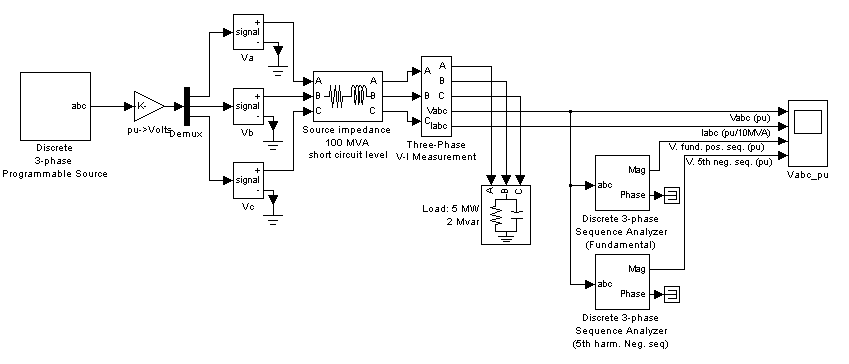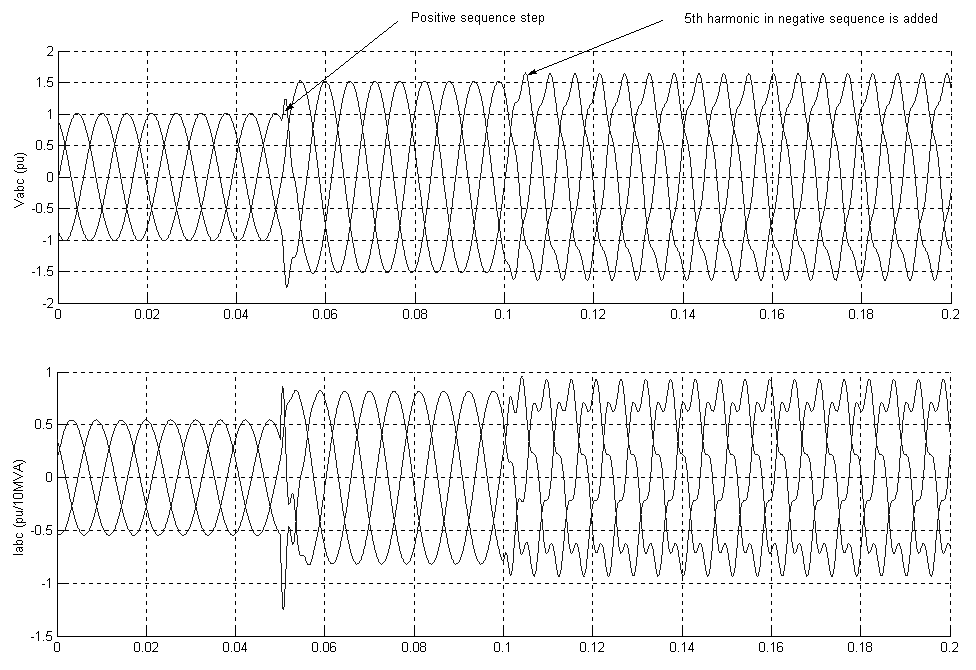| SimPowerSystems |
  |
3-Phase Programmable Voltage Source
Implement a three-phase source signal with programmable time variation of amplitude, phase, frequency, and harmonics
Library
Electrical Sources
Description

Use this block to generate a three-phase sinusoidal signal with time-varying parameters. You can program the time variation for the amplitude, phase, or frequency of the fundamental component of the source. In addition, two harmonics can be programmed and superimposed on the fundamental signal.
The 3-Phase Programmable Source block can be used to control the voltage of three Controlled Voltage Source blocks or the current of three Controlled Current Source blocks.
Dialog Box and Parameters

- Positive-sequence: [Amplitude Phase (degrees) Freq. (Hz)]
- The amplitude in volts or amperes, the phase in degrees, and the frequency in hertz of the positive-sequence component of the source.
- Time variation of
- Specify the parameter for which you want to program the time variation. Select None if you do not want to program the time variation of the source parameters. Select Amplitude if you want to program the time variation of the amplitude. Select Phase if you want to program the time variation of the phase. Select Frequency if you want to program the time variation of the frequency.
- Note that the time variation applies on the three phases of the source.
- Type of variation
- Specify the type of variation that is applied on the parameter specified by the Time variation of parameter. Select Step to program a step variation. Select Ramp to program a ramp variation. Select Modulation to program a modulated variation.
- Step magnitude
- Specify the amplitude of the step change. This parameter is only visible if the Type of Variation parameter is set to Step.
- Rate of change (value/s)
- Specify the rate of change, in volt/seconds or ampere/second. This parameter is only visible if the Type of Variation parameter is set to Ramp.
- Amplitude of the modulation
- Specify the amplitude of the modulation for the source parameter specified in the Time variation of parameter. This parameter is only visible if the Type of variation parameter is set to Modulation.
- Frequency of the modulation (Hz)
- Specify the frequency of the modulation for the source parameter specified in the Time variation of parameter. This parameter is only visible if the Type of variation parameter is set to Modulation.
- Variation timing (s): [Start End]
- Specify the time, in seconds, when the programmed time variation takes effect and the time when it stops.
- Harmonic generation
- If selected, two harmonics can be programmed to be superimposed on the fundamental signal of the source.
- A: [Order(n) Amplitude Phase(degrees) Seq(0, 1 or 2)]
- Specify the order, amplitude, phase, and the type of sequence of the first harmonic to be superimposed on the fundamental signal. This parameter is only visible if the Harmonic generation parameter is selected.
- B: [Order(n) Amplitude Phase(degrees) Seq(0, 1 or 2)]
- Specify the order, amplitude, phase, and the type of sequence of the second harmonic to be superimposed on the fundamental signal. This parameter is only visible if the Harmonic generation parameter is selected.
- Harmonic timing (s): [Start End]
- Specify the time, in seconds, when the harmonic generation is superimposed on the fundamental signal and the time when it stops. This parameter is only visible if the Harmonic generation parameter is selected.
Inputs and Outputs
The output of the block is a vectorized signal containing a three-phase signal [a b c] of the programmed source. Use a Demux block and three Controlled Voltage Source blocks to generate a three-phase voltage source or use three Controlled Current Source blocks to generate a three-phase current source.
Example
The psb3phsignalseq.mdl circuit illustrates the use of the discrete version of the 3-Phase Programmable Source block to create a programmable voltage source.
A positive-sequence of 1.0 p.u., 0 degrees is specified for the fundamental signal. At t = 0.05 s a step of 0.5 p.u. is applied on the positive-sequence voltage magnitude, then at t = 0.1 s, 0.1 p.u. of fifth harmonic in negative sequence is added to the 1.5 p.u. voltage.
In order to start simulation in steady state, the three Controlled Voltage Source blocks are initialized with a positive-sequence voltage of 25 kV, 0 degree, 60 Hz. The three-phase voltage and current are measured at the output of the source impedance.


 | 3-Phase Fault | | 3-Phase Sequence Analyzer |  |






